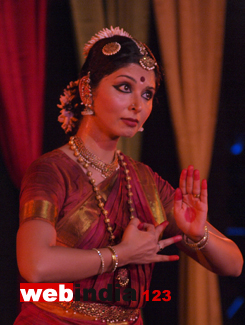|
|

|
|

| INTRODUCTION PERFORMANCE MUSIC, COSTUME AND MAKE UP TECHNIQUE DANCERS |
 Bharatanatyam technique may be discussed under two broad heads, namely nritta
and abhinaya. The nritta aspect has to be understood as a technique of human
movement.
Bharatanatyam technique may be discussed under two broad heads, namely nritta
and abhinaya. The nritta aspect has to be understood as a technique of human
movement.
In Indian dance the human body has been conceived of, as a mass which can be equally divided along a central median. Further movement is determined by the nature of deflections from this median. It is only when the weight is equally divided that the completely balanced (sama-bhanga) position emerges. In poses where there is only one deflection, the slightly imbalanced (abhanga) position emerges. In postures with more than two deflections on opposite sides of the central median, the thrice-deflected (tribhanga) position emerges. Bharatnatyam conceives of movement in space mostly along either straight lines or in triangles.
The head forms the first unit and lateral movements of the head are common. The torso is seen as another unit and is hardly ever broken up into the upper or the lower torso. The lower limbs are seen either as straight lines or two sides of an imaginary triangle in space. The upper limbs either follow the lower limbs or weave circular patterns along space which is covered by the lower limbs. It is the latter aspect, along with the use of the torso as a single unit, that gives Bharatnatyam its particularity.
The dancer begins with samapada position which is the first basic position, with the feet facing front. The body of the dancer is neither relaxed nor unduly taut. This is followed by turning of the feet sideways which is known as the 'Kalai tiruppudal' in Tamil. Then comes the 'ardhamandali' position in which the feet are sideways and the knees also bend sideways. The ardhamandali is often termed as the 'ukkaramandali', the Tamil word 'ukkar' literally meaning sitting. The entire movement pattern is built from the first movement in which the feet are turned sideways, the knees are bent and the arms either extended out or placed firmly on the waist. The dancer is trying to achieve a series of triangles. The line joining the two shoulders may be conceived as the base of one triangle and the waist as the imaginary apex of an inverted triangle. From this apex a second triangle is conceived with the thighs, as the two sides and the line joining the two knees, as the base of this triangle. The third triangle is formed by the space covered by the two calves and the line joining the two knees. The arms reinforce this by forming other triangles on either side-the extended arm forming one side of the triangle and the line joining the hand to the knee suggesting the second side .
Foot contact is important. In the first position, the entire foot touches the ground and weight is equally distributed. The stamping of this flat foot on the ground is known as 'tattu'. In the same position the second type of foot contact occurs where only the toes of one foot touch the ground and the heel is raised; the third type of foot contact results when the heel touches the ground and the toe is raised. These are the usual movements in the 'ardhamandali' position. Then follows the permutation and combination of these positions by the use of either one foot or both the feet.
The unit which emerges as a coordinated pattern of movement of the feet, thighs, torso, arms, hands, neck, head and the eyes is knows as the 'adavu'. The adavu is perhaps the closest to the cadence of movement called the 'Karana' in the Natyasastra terminology. The adavu always begins with a static position in place and then explores the possibility of movement through different types of foot contacts; with the sole, the toe or the heel and the combination of these, first in place and then in space.
| Pages | 1 |
2 | 3 |